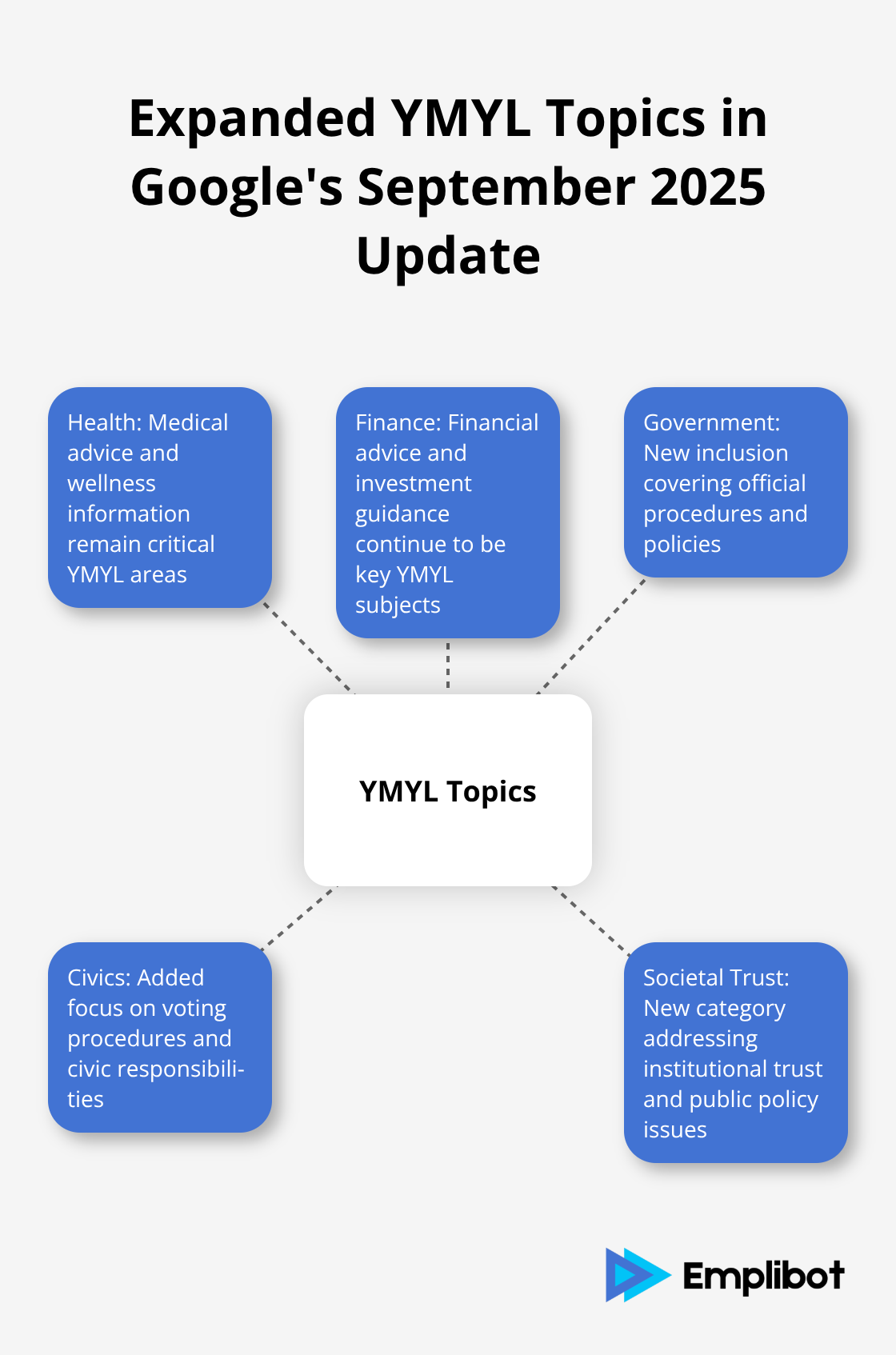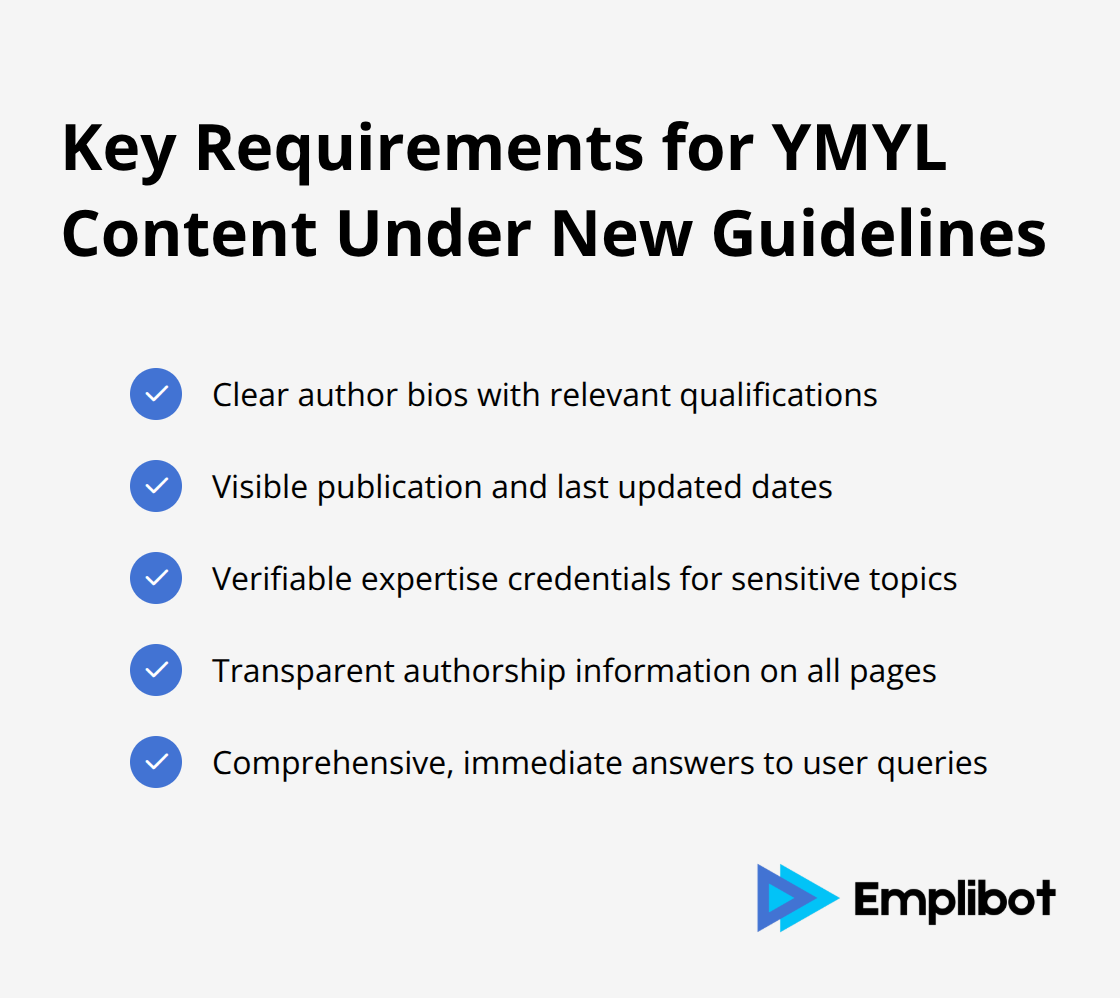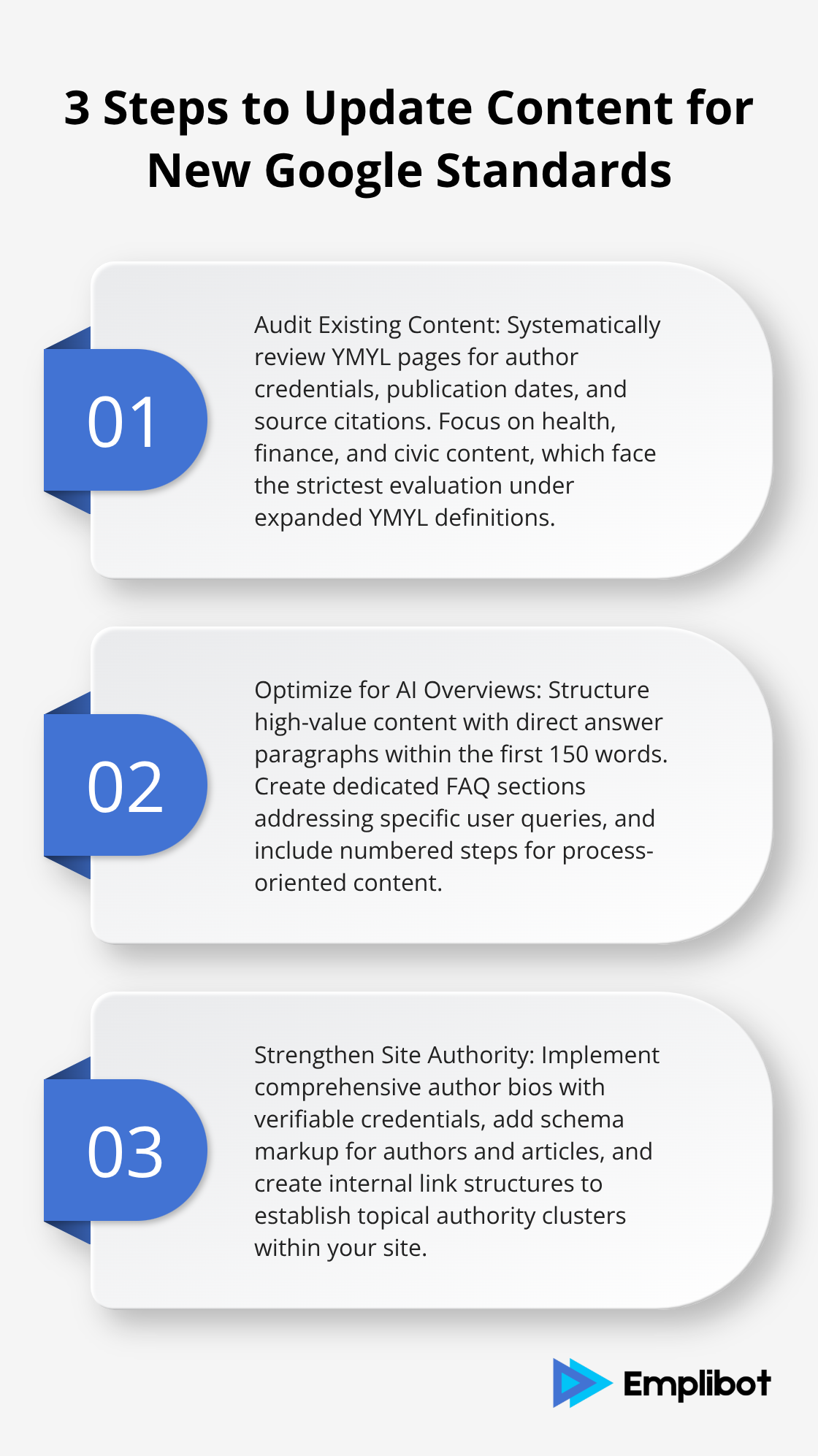Google released its September 2025 Rater Guidelines Update on September 11, bringing significant changes to how content gets evaluated. The update adds new YMYL clarifications and introduces rating instructions for AI Overviews.
These changes directly impact how search engines assess content quality and trustworthiness. We at Emplibot have analyzed the key shifts to help you adapt your content strategy effectively.
What Specific Changes Did Google Make
The September 11, 2025 update expanded the Search Quality Rater Guidelines from 181 to 182 pages, introducing three major shifts that reshape content evaluation standards. Google broadened YMYL definitions to explicitly include government, civics, and societal trust topics, moving beyond the previous focus on health and financial content. This expansion means content about voting procedures, institutional trust, and public policy now faces the same rigorous evaluation standards as medical advice or investment guidance.

AI Overviews Receive Official Rating Criteria
Google added comprehensive examples for rating AI Overviews, the AI-generated summaries that appear at the top of search results. These rating instructions mirror those used for featured snippets and knowledge panels, establishing AI Overviews as a permanent fixture in search evaluation. Quality raters now assess AI-generated content using the same E-E-A-T standards applied to human-created content, focusing on accuracy, source attribution, and usefulness.
Enhanced Requirements for Source Transparency
The updated guidelines strengthen requirements for content sourcing and author credibility, particularly for YMYL topics. Google now expects clear author bios, publication dates, and verifiable expertise credentials on all sensitive content. Pages without transparent authorship information face automatic low ratings in YMYL categories (especially in finance, health, and civic topics).
Stricter Content Quality Assessment Standards
The guidelines emphasize that content must provide immediate, comprehensive answers to user queries, directly influencing the Needs Met Rating that affects algorithm performance. Google raised the bar for what constitutes helpful content, requiring pages to demonstrate clear value and expertise. Content creators must now prove their authority through verifiable credentials and transparent sourcing practices.
These changes create new opportunities and challenges for content strategy, particularly in how you structure and optimize your content for both human readers and AI systems. Understanding these shifts becomes crucial as Google continues to protect sites from scaled content abuse and refine its evaluation criteria.
How Do These Changes Impact Your Strategy
The September 2025 updates demand a complete overhaul of how you approach content creation, particularly for topics that touch government, health, finance, or civic issues. The September 11, 2025 guidelines update added clarifications around YMYL definitions and examples for rating newer features. Pages without clear expertise signals automatically receive low ratings, which makes transparent authorship non-negotiable for success.

Immediate YMYL Content Requirements
Your YMYL pages need complete author overhauls within 60 days to maintain performance. Add publication dates, last updated stamps, and detailed author credentials that include relevant degrees, certifications, or professional experience. Google specifically looks for verifiable expertise markers like medical licenses for health content or CPA certifications for financial advice. Remove any content where you cannot establish clear author authority, as anonymous YMYL content faces immediate devaluation under the new standards.
AI-Optimized Content Structure Changes
Structure your content with scannable answer blocks positioned within the first 200 words of each page. The updated guidelines include AI Overview examples that show how content gets evaluated for these features. Create distinct sections that answer specific questions, followed by detailed explanations with source links. This format increases your chances of appearance in AI summaries while it maintains user interest for full article reads.
Trust Signal Implementation Strategy
Install schema markup for author information, article publication dates, and organization details across all content. Add clear contact information, privacy policies, and about pages that establish your site’s legitimacy. Link to authoritative external sources within your content, as Google now weighs source quality heavily in content evaluation. Sites with strong internal connections and external authority links receive higher trust scores in the updated evaluation framework.
These strategic shifts require immediate action across your entire content library, but the implementation process becomes manageable when you break it down into specific, measurable steps that adapt to digital marketing changes.
How Do You Update Your Content for the New Standards
Begin your compliance process with a systematic audit of existing content that uses specific criteria from the September 2025 guidelines. Check each YMYL page for author credentials, publication dates, and source citations within 48 hours of implementation. Pages that lack clear expertise indicators need immediate updates or removal from your site index. Focus first on health, finance, and civic content, as these categories face the strictest evaluation under the expanded YMYL definitions. Run automated checks for schema markup gaps, outdated information, and pages without clear authorship attribution.
Target AI Overview Optimization Through Answer Blocks
Structure your high-value content with direct answer paragraphs that appear within the first 150 words of each page. Google’s AI Overview examples show preference for content that provides immediate answers followed by supporting details and citations. Create dedicated FAQ sections that address specific user queries with 50-75 word responses, then expand with comprehensive explanations below. Add numbered steps for process-oriented content and include relevant statistics with named sources to increase selection probability for AI summaries.
Strengthen Site Authority with Automated Trust Signals
Install comprehensive author bio sections with verifiable credentials, professional backgrounds, and contact information across all content. Add schema markup for authors, organizations, and articles to establish clear content ownership and expertise signals. Create internal link structures that connect related content and establish topical authority clusters within your site. Implement fact-checked boxes with statistics from named sources, publication dates, and last-updated timestamps on every page.
Audit Content Quality Against New Standards
Review your content library for pages that fail to meet the enhanced quality requirements (particularly those without clear value propositions or expert authorship). Remove or consolidate thin content that cannot demonstrate expertise or provide comprehensive answers to user queries. Use tools like MarketMuse or Clearscope to ensure your content meets industry standards for depth and relevance. Update publication dates on all revised content and add revision notes that explain what changed. Test your pages against the Needs Met Rating criteria to identify content gaps that prevent comprehensive query satisfaction.

Final Thoughts
The September 2025 Rater Guidelines Update creates new standards that content creators must follow to maintain search visibility. Google expanded YMYL definitions to include civic and governmental topics, while AI Overviews now receive official evaluation criteria that match featured snippet standards. These changes demand immediate action on author credibility, source transparency, and content structure optimization.
Success under the new guidelines requires comprehensive trust signals across your entire content library. Author bios with verifiable credentials, publication dates, schema markup, and clear source citations become mandatory for YMYL content. Pages without these elements face automatic devaluation in Google’s evaluation framework.
We at Emplibot automate WordPress blog management through keyword research, content creation, and SEO optimization while we produce high-quality content tailored to your business needs. Our platform handles author bio creation, schema markup implementation, internal link strategies, and fact-checked statistics blocks that align with the updated guidelines (without requiring manual oversight). Your next step involves auditing existing content against the new standards within 30 days, then implementing systematic updates that strengthen expertise signals and improve content structure for AI consumption.

